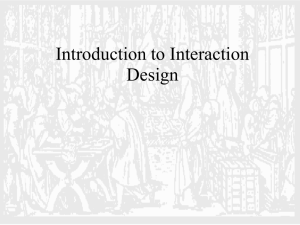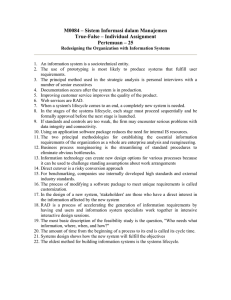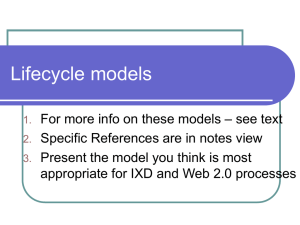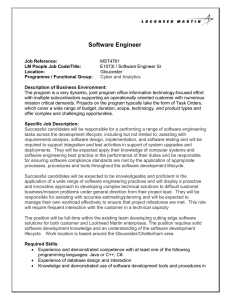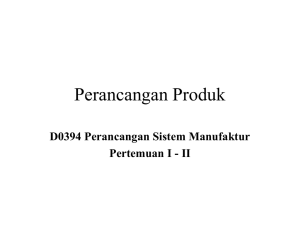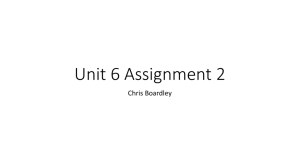CS 411W - Week I Notes
advertisement
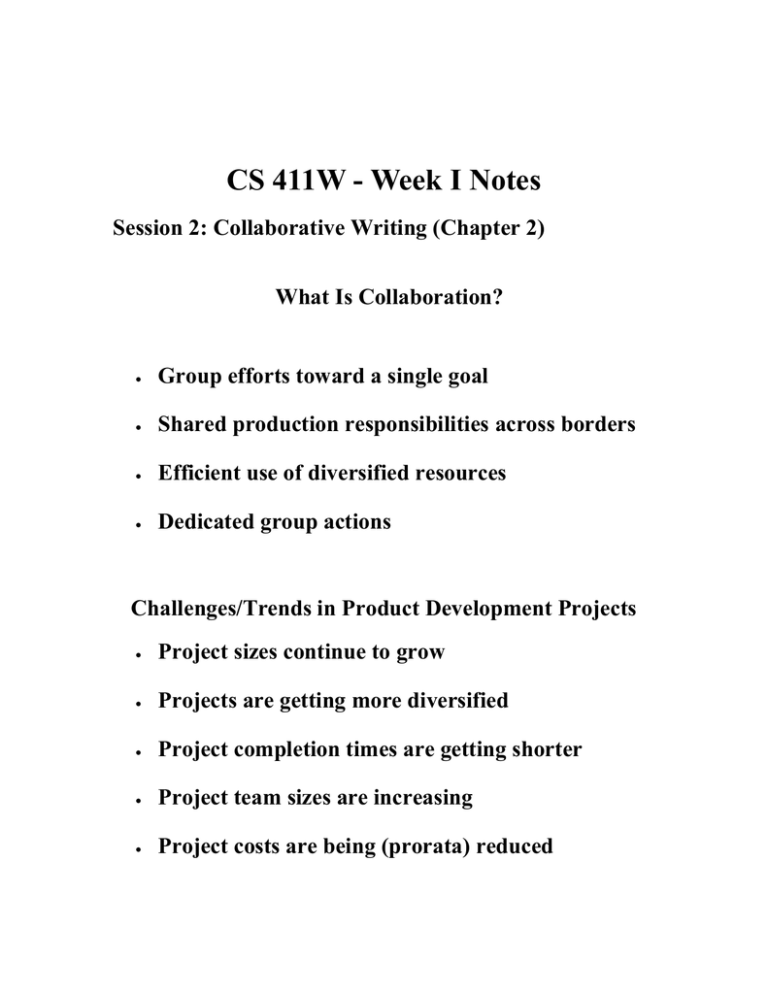
CS 411W - Week I Notes Session 2: Collaborative Writing (Chapter 2) What Is Collaboration? Group efforts toward a single goal Shared production responsibilities across borders Efficient use of diversified resources Dedicated group actions Challenges/Trends in Product Development Projects Project sizes continue to grow Projects are getting more diversified Project completion times are getting shorter Project team sizes are increasing Project costs are being (prorata) reduced Project Planning is a large compendium of written documents Why Collaborate? Project growth requires larger efforts for planning Project diversification requires larger staff Shorter completions require more concentrated efforts Team size growth requires expanded team communication Reduced costs demand increased efficiency Written documents are beyond a single person's efforts Collaboration Advantages Division of Labor: Increased effectiveness of group members' activities (divide and conquer) Speed: Reduced time in processing (efficiency in numbers) Expertise: o Effective utilization of multi-disciplines o Ability to employ global resources Check on Conditioned Reasoning: o Improved quality from multiple reviewers o Helps prevent oversight and mistakes Synergy: o Generates new ideas o Clarifies concepts Group Learning and Ownership: o Fosters organizational identity o Hone skills/expand knowledge o Control and empowerment o Potential for reduction in levels of management Disadvantages in Collaboration “Group Think” o Potential to stifle individual qualities/contribution o Domineering members can override complacent members o May lead to middle-of-the road solutions to satisfy group differences Withholding of Effort or Information o Resistance to team leader o Concern over sharing ideas/receiving recognition o Less contribution than in individual environment o Group accountability buffers individual accountability Critical Team Values Mutual Respect Loyalty – to each other, to the effort Diversity – complimentary (as opposed to competing) mix of capabilities Trust – open/honest/effective communication Team Member Responsibilities Listen Be open to new ideas and experiences Be ready/willing to learn Respect others as they respect you Be patient Don’t always be assertive or competitive Don’t always need to be right Give everyone special treatment Ideal Collaboration Group Makeup Dynamic individuals Professional perspective Team Player Well defined goal Diversified group (background and profession) Good Collaboration Method Elected team leader Agree on a purpose/objective/charter Establish a mechanism to foster open communications among all team members Develop an schedule and WBS Establish overall approach, style guides, formatting and communications conventions Assign Tasks o Achievable o Definitive completion o Measurable milestones Defined review process Document the Collaboration/team approach Product Development Product development, perhaps the most complex of all the main business processes, takes place in an environment where: Conditions change over time. The pace of change is accelerating with eBusiness. Each product has unique aspects and requirements. Consistent procedures do not guarantee a successful product. Each new product will have its own mix of requirements: technical performance, cost trade-offs and time-to-market. A flexible product development process allows for these changes and leverages the ever-evolving environment to achieve the most benefit. Product Development Concepts What is a product How do we get a product What steps are needed for Product Management How long does a product process last Product Definition Item – i.e. car, consumable, or service Must be designed, developed, marketed, and enhanced Has a “lifecycle” – i.e. goes through stages of change, enhancement (and potentially replacement) o Example - lifecycle of the automobile vs. lifecycle of the 8-track tape player Evolves over time – often building on an initial concept or expanding an initial product o Example – cell phone evolution to “blackberry” capabilities Product Development Process The process Closely parallels Project Management o Often result of Project effort (example business-to-business or eBusiness projects which evolve to product) Product Development often includes multiple Project Management evolutions (sequentially or in parallel – “concurrent engineering”) o Example: developing an aircraft – aerodynamics, structure, propulsion, sensors and electronics all individual Projects Planning for Product Development vs. Project Planning: o Product planning deals with characteristics, functions, features, marketability, produceability, and lifecycle (i.e. externally oriented) o Project planning deals with internal objectives and strategies to achieve end-product (i.e. internally focused) o Project Plan often included as a portion of the overall Product Plan o Product Plan and Development Process requires flexibility and long term view vs. Project Plan and Process which is more rigid with narrower scope and defined-term view Product Definition o o o Product environment – where does it operate, who are the customers, What is it (physically, functionally) - How will it meet the goals and objectives Product Design o Functional details o Architectural details o Performance Specifications o Testing approach Product development, prototyping, testing o Software/Hardware development o Product documentation (design, test, users/maintenance manuals, etc) o Objective - what product will do Prototype – Proof of Concept basis (or “platform”) for incremental/spiral development Production review o Production feasibility assessment o Production plan and cost assessment Product marketing Product delivery - maintenance – update o Testing and acceptance o After-sales support o Life-cycle maintenance/improvement plan Product Development Process Flow: Identify the "Bright Idea" i.e.Product Objective Define the Requirements – What does it do, where? Requirements Gather Outside Information (Patent Search, Market Research) The Design Phase Prototyping Design Prototyping Production Production Considerations for Product Definition and Development Planning: What are the customer requirements? Consider life span, product function, strength, rigidity, flexibility, product look, feel and performance. How much will the product cost? It is important to know how much a customer will pay for the product because it must be produced for much less. How many items are expected to be sold, and in what time frame? The quantity to be sold will drastically affect the cost of the product, and what processes are used to produce it. How will the product be marketed and sold? Items to consider include how it will be presented, weight, packaging, shipping, colors, sizes, etc. What is the timing required? Some products are time sensitive. A toy, for instance may need to be on the shelf in October to sell for Christmas. What is the expected life of the product? What product safety issues are involved? Are there safety concerns with misuse? How can the product fail and what are the consequences? This is often referred to as FMEA or Failure Mode and Effects Analysis. What are the hard points of the "Bright Idea"? What are the points that cannot change? What areas can change if needed to better meet other, more important requirements? Will a warranty be provided? If so, what will it cover and how will it be handled? What governmental regulations or certification requirements must be met? Are there legal concerns like patent infringement, or liability issues? Will the product have social concerns like disposability or recyclability? Some thought must be given to manufacturing issues like cost, time, material, size, weight, complexity, where it might be made, etc. Government regulations may also limit these choices -- like material properties. (These issues will be addressed in depth through the design process, but a good feel for what is expected up front is helpful.) Where will the product be made? Though this question really should not be answered prior to looking at things like "how many" and "what processes", you should know how you feel about ON SHORE and OFF SHORE manufacturing. Requirements Definition Requirements definition: simply means "figuring out what to make before you make it." When to define requirements: the requirements definition phase must be completed before any substantial development begins Who should define requirements: Product requirements serve as a bridge between business and engineering, so the people who generate them should sit between business and engineering as well. Requirements Document Example: http://fast.faa.gov/ams_templates/temprd.htm Piecing it together: Typical Product Development Documentation Profile Product Development Documentation Explanatory Documents Concept Product selection rationale Design Developme nt Production Specifications Drawings and Plans Product Definition Product Description Product design options Preliminary and Detailed Design Product Development Plan Contract or Work Order Development Specification Test and Acceptance Plan Instruction and Maintenance Manuals Production Specification “As-build” plans and Procedures Acceptance, Marketing, Support
